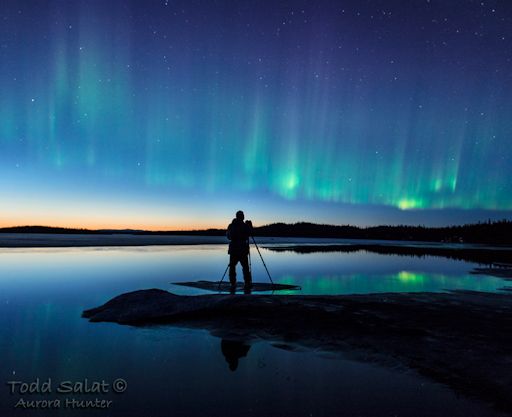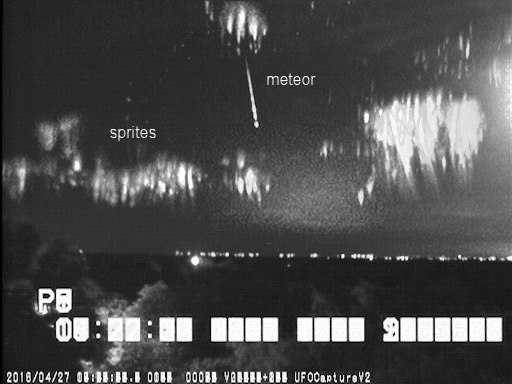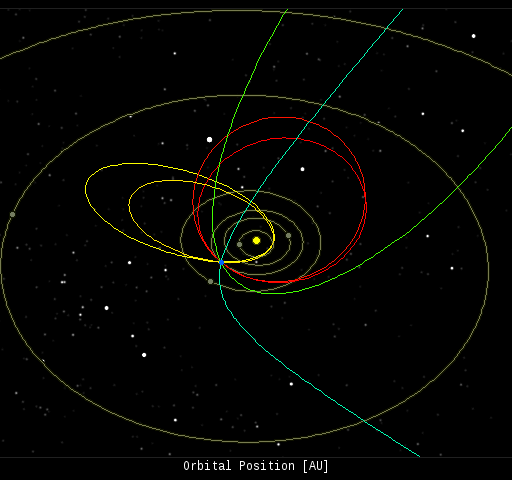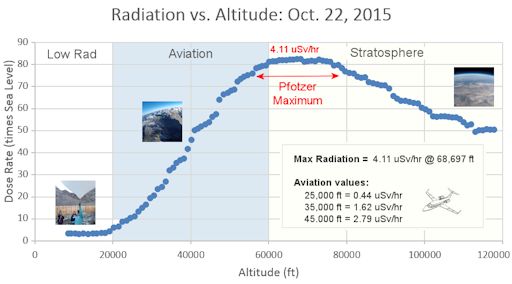On May 9th, the planet Mercury will pass in front of the sun, producing an inky-black spot on the solar disk. Catch it live on the Internet, courtesy of the Coca-Cola Space Science Center in Columbus, Georgia. | | | SPACE ROSES FOR MOTHER'S DAY: Nothing says "Happy Mother's Day" quite like a red rose from the edge of space. Click here to see what we mean. There's still time to buy a space rose for your own mom. Order one now from Earth to Sky Calculus for delivery before May 8th. All proceeds support student space weather research. SPRINGTIME AURORAS: On Saturday, April 30th, Earth crossed a fold in the heliospheric current sheet and entered a region of space filled with negative-polarity magnetic fields. This sparked an outburst of springtime auroras around the Arctic Circle. Todd Salat photographed the display from the shore of Lake Louise, Alaska: 
"I took this picture during the darkest part of the night on April 30, 2016, around 1:25 am," says Salat. "The auroras were reflecting beautifully from the surface of the lake during my self-portrait." The orange glow in Salat's picture is caused by the Midnight Sun, just below the horizon. At this time of year, auroras have a hard time being seen at Arctic latitudes because of the persistent twilight. Nevertheless, Salat got a good shot. "I keep thinking this is the end of the aurora season for high northern latitudes," he says, "but then I think of that infamous 1973 quote from baseball legend Yogi Berra, 'It ain't over till it's over.'" Indeed, more auroras could be in the offing. NOAA forecasters estimate a 40% to 50% chance of G1-class geomagnetic storms on April 30th-May 1st as Earth moves into a weekend solar wind stream. Aurora alerts: text or voice Realtime Aurora Photo Gallery "SPACE LIGHTNING" OVER TEXAS: You know what comes out of the bottom of thunderstorms: lightning. On April 27th, Kevin Palivec of Hawley, Texas, saw something coming out of the top. "Storms moving across Texas produce more than just rain, wind, hail and tornadoes!" says Palivec. "They also produce a lot of space lightning called 'sprites.' This is a stacked image of all the sprites I caught over storms as they moved across Texas towards Dallas/Ft Worth--with one meteor thrown in!" 
Because sprites are associated with thunderstorms, they tend to occur in late spring and summer. Palivec's photo shows that sprite season is now underway. Sprites are a true space weather phenomenon, inhabiting the upper reaches of Earth's atmosphere alongside noctilucent clouds, meteors, and some auroras. Some researchers believe they are linked to cosmic rays: subatomic particles from deep space striking the top of Earth's atmosphere produce secondary electrons that, in turn, could provide the spark that triggers sprites. "Sprites develop in mid-air very high above Earth's surface, around 80 km altitude, growing in both directions, first down, then up," says explains lightning scientist Oscar van der Velde of the Technical University of Catalonia, Spain. "An individual sprite lasts only around 5-50 milliseconds but a sequence of them can be seen to 'dance' over storm fronts for a much longer period of time." Although sprites have been seen for at least a century, most scientists did not believe they existed until after 1989 when sprites were photographed by cameras onboard the space shuttle. Now "sprite chasers" routinely photograph sprites from their own homes. Give it a try! Realtime Sprite Photo Gallery
Realtime Space Weather Photo Gallery
Realtime Comet Photo Gallery Every night, a network of NASA all-sky cameras scans the skies above the United States for meteoritic fireballs. Automated software maintained by NASA's Meteoroid Environment Office calculates their orbits, velocity, penetration depth in Earth's atmosphere and many other characteristics. Daily results are presented here on Spaceweather.com. On Apr. 30, 2016, the network reported 7 fireballs.
(7 sporadics)  In this diagram of the inner solar system, all of the fireball orbits intersect at a single point--Earth. The orbits are color-coded by velocity, from slow (red) to fast (blue). [Larger image] [movies] Potentially Hazardous Asteroids ( PHAs) are space rocks larger than approximately 100m that can come closer to Earth than 0.05 AU. None of the known PHAs is on a collision course with our planet, although astronomers are finding new ones all the time. On April 30, 2016 there were potentially hazardous asteroids. Notes: LD means "Lunar Distance." 1 LD = 384,401 km, the distance between Earth and the Moon. 1 LD also equals 0.00256 AU. MAG is the visual magnitude of the asteroid on the date of closest approach. | | Cosmic Rays in the Atmosphere | | Situation Report -- Oct. 30, 2015 | Stratospheric Radiation (+37o N) | | Cosmic ray levels are elevated (+6.1% above the Space Age median). The trend is flat. Cosmic ray levels have increased +0% in the past month. | | Sept. 06: 4.14 uSv/hr (414 uRad/hr) | | Sept. 12: 4.09 uSv/hr (409 uRad/hr) | | Sept. 23: 4.12 uSv/hr (412 uRad/hr) | | Sept. 25: 4.16 uSv/hr (416 uRad/hr) | | Sept. 27: 4.13 uSv/hr (413 uRad/hr) | | Oct. 11: 4.02 uSv/hr (402 uRad/hr) | | Oct. 22: 4.11 uSv/hr (411 uRad/hr) | These measurements are based on regular space weather balloon flights: learn more. Approximately once a week, Spaceweather.com and the students of Earth to Sky Calculus fly "space weather balloons" to the stratosphere over California. These balloons are equipped with radiation sensors that detect cosmic rays, a surprisingly "down to Earth" form of space weather. Cosmic rays can seed clouds, trigger lightning, and penetrate commercial airplanes. Our measurements show that someone flying back and forth across the continental USA, just once, can absorb as much ionizing radiation as 2 to 5 dental X-rays. For example, here is the data from a flight on Oct. 22, 2015: 
Radiation levels peak at the entrance to the stratosphere in a broad region called the "Pfotzer Maximum." This peak is named after physicist George Pfotzer who discovered it using balloons and Geiger tubes in the 1930s. Radiation levels there are more than 80x sea level. Note that the bottom of the Pfotzer Maximim is near 55,000 ft. This means that some high-flying aircraft are not far from the zone of maximum radiation. Indeed, according to the Oct 22th measurements, a plane flying at 45,000 feet is exposed to 2.79 uSv/hr. At that rate, a passenger would absorb about one dental X-ray's worth of radiation in about 5 hours. The radiation sensors onboard our helium balloons detect X-rays and gamma-rays in the energy range 10 keV to 20 MeV. These energies span the range of medical X-ray machines and airport security scanners. | | The official U.S. government space weather bureau | | | The first place to look for information about sundogs, pillars, rainbows and related phenomena. | | | Researchers call it a "Hubble for the sun." SDO is the most advanced solar observatory ever. | | | 3D views of the sun from NASA's Solar and Terrestrial Relations Observatory | | | Realtime and archival images of the Sun from SOHO. | | | from the NOAA Space Environment Center | | | the underlying science of space weather | | 
